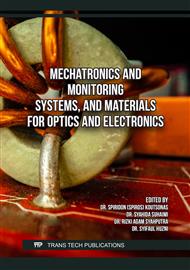[1]
HUANG Qi, XUAN Liang, ZHU Jie, et al. Analysis of sealing performance of combined seal structure with metal C-ring with built-in spring, Vibroengineering procedia. 51(2023) 94-100.
DOI: 10.21595/vp.2023.23494
Google Scholar
[2]
GAO Bingjun, GAO Han, JIAN Dong, et al. Analysis of sealing performance of metal B-ring self-tightening structure, Processes. 10(2022) 1-27.
DOI: 10.3390/pr10061084
Google Scholar
[3]
CHEN Tingkun, WANG Lin, XU Jin, et al. Effect of groove texture on deformation and sealing performance of engine piston ring, Machines. 10(2022) 1020.
DOI: 10.3390/machines10111020
Google Scholar
[4]
SCHELLER J, BAUR P J. Characterization of leakage, clamping force and retaining force of reusable sealing frame with elastomer O-ring for thin plasma polymeric coated thermoplastic polyester-ether films, Vacuum. 192(2021) 1-8.
DOI: 10.1016/j.vacuum.2021.110501
Google Scholar
[5]
BLANTON P, KURT E K. Performance testing of spring energized C-rings for use in radioactive material packagings containing tritium, Pubinfo. 8(2007) 1-7.
Google Scholar
[6]
HE Dongsheng, REN Hang, ZHANG Linfeng, et al. Study on sealing performance of downhole V-shaped metal sealing ring, Lubrication Engineering. 45(2020) 81-86.
Google Scholar
[7]
GONG Xueting. Research on characteristics of w-shaped metal seal ring for aero-engine: submitted to Beijing University of Chemical Technology (2011).
Google Scholar
[8]
LI Jianhui, WEN Shuaifang, SUN Dan, et al.Leakage characteristics and formula construction of W-shaped elastic metal seals, Journal of Aerospace Power. 63(2023) 1-14.
Google Scholar
[9]
ZHANG Dongge, ZHANG Fuying, WANG Shiqiang. The optimization design for structure and operating parameters of Y sealing ring based on ANSYS, Lubrication Engineering. 37(2012) 87-90.
Google Scholar
[10]
WANG Shiqiang, ZHANG Fuying, ZHANG Dongge. Study on sealing performance of Y-ring based on ANSYS, Lubrication Engineering. 37(2012) 61-64+68.
Google Scholar
[11]
XIE Jun, ZHOU Mi, YANG Tian, et al. Elastoplastic contact analysis of metal O-ring based on ANSYS, Fluid Machinery. 37(2009) 43-46.
Google Scholar
[12]
WANG Guozhi, LIU Huanlong, LIU Niehao, et al. Effect of water hydraulic component surface roughness on static sealing property of O-ring, Lubrication Engineering. 38(2013) 87-91.
Google Scholar
[13]
WEI Liejiang, XIONG Qingyu, LUO Xichun, et.al. Finite element analysis of the O-ring squeezed into the sealing clearance based on ABAQUS, Proceedings of 2016 International Symposium on Advances in Materials Science (IAMS 2016). 2016(11047) 2129-2137.
Google Scholar
[14]
SHEN Mingxue, PENG Xudong, XIE Liyang, et al. Deformation characteristics and sealing performance of metallic O-rings for a reactor pressure vessel, Nuclear Engineering & Technology. 48(2016) 533-544.
DOI: 10.1016/j.net.2015.11.009
Google Scholar
[15]
Liejiang Wei, Qingyu Xiong, Xichun Luo, et al. Finite element analysis of the O-ring squeezed into the sealing clearance based on ABAQUS, DEStech Transactions on Engineering and Technology Research. 31(2017) 1-18.
DOI: 10.12783/dtetr/apetc2017/11047
Google Scholar
[16]
FANG Guifang, PZHAN Genggao, WEI Long. Effect of surface topography on contact property of the end face for mechanical seal, Applied Mechanics and Materials. 419(2013) 292-298.
DOI: 10.4028/www.scientific.net/amm.419.292
Google Scholar
[17]
CUI Wei, WANG Lixin, LUO Yanjun. Modeling of three-dimensional single rough rock fissures: A study on flow rate and fractal parameters using the Weierstrass-Mandelbrot function, Computers and Geotechnics. 144(2022) 104655.
DOI: 10.1016/j.compgeo.2022.104655
Google Scholar
[18]
Zhang Qiang, Xiaoqian Chen, Yiyong Huang, et al. Fractal modeling of fluidic leakage through metal sealing surfaces, AIP Advances. 8(2018) 1-19.
DOI: 10.1063/1.5023708
Google Scholar
[19]
SONG Xinyi, HUANG Song, HU Hui, et al. Analysis of sealing performance of a kind of profiled rubber gasket used in the radial contact seal structure, Proceedings of the Institution of Mechanical Engineers, Part E: Journal of Process Mechanical Engineering. 235(2020) 857-862.
DOI: 10.1177/0954408920971995
Google Scholar
[20]
HAN Ting, FAN Jun. Ultrasonic measurement of contact stress at metal-to-metal interface based on a real rough profile through modeling and experiment, Measurement. 217(2023) 113046.
DOI: 10.1016/j.measurement.2023.113046
Google Scholar
[21]
ZHAO Yannan, ZHAO Caiyou, WANG Liuchong, et al. A rail corrugation evaluation method using fractal characterization based on structure function method, Wear. 506-507(2022) 204454.
DOI: 10.1016/j.wear.2022.204454
Google Scholar
[22]
ZHU Hongjun. ANSYS 14.5 practical guide to thermal fluid-solid coupling, third ed., Posts & Telecom Press, Beijing, 2014.
Google Scholar
[23]
WANG Jitao. Modern thermodynamics—new concepts based on the second law of thermodynamics, Progress in Natural Science: Materials International. 19(2009) 125-135.
DOI: 10.1016/j.pnsc.2008.07.002
Google Scholar
[24]
PENG Dingyu, ROBINSON Donald B. A new two-constant equation of state, Industrial & Engineering Chemistry Fundamentals. 15(1976) 59-64.
DOI: 10.1021/i160057a011
Google Scholar
[25]
BRUNETIÈRE Noël, TOURNERIE Bernard, FRÊNE Jean. Influence of fluid flow regime on performances of non-contacting liquid face seals, Journal of tribology. 124(2002) 515-523.
DOI: 10.1115/1.1456453
Google Scholar
[26]
CHEN Yuan, PENG Xudong, WANG Bingqing, et al. Experimental and theoretical investigations on dry gas seal transient performance and its disparity with steady performance, Proceedings of the Institution of Mechanical Engineers, Part J: Journal of Engineering Tribology. 236(2022) 1661-1673.
DOI: 10.1177/13506501211064079
Google Scholar
[27]
CHEN Daiheng, MASUDA Kazuhiko. Equivalent elastic modulus of asymmetrical honeycomb, ISRN Mechanical Engineering (Print). 2011(2011) 1-10.
DOI: 10.5402/2011/570140
Google Scholar
[28]
GÖRGÜN Erdem, AKŞIT Mahmut Faruk, DOĞU Yahya. A study of cloth seal leakage performance based on geometry and pressure load, Energies. 13(2020) 5884.
DOI: 10.3390/en13225884
Google Scholar


